Draft heavy two-link armored personnel carrier DBTR-T
BTR - armored personnel carrier;
TBTR - heavy armored personnel carrier;
DBTR - two-tier armored personnel carrier;
PU - launcher;
DU - remote-controlled installation;
MTO - engine compartment;
EMT - electromechanical transmission.
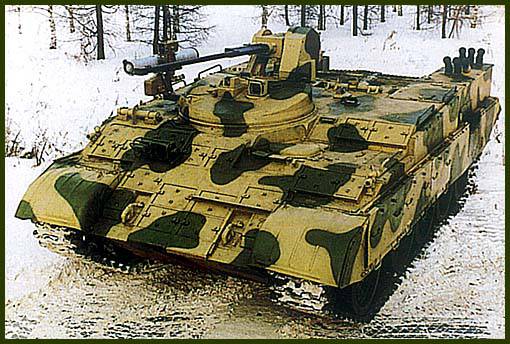
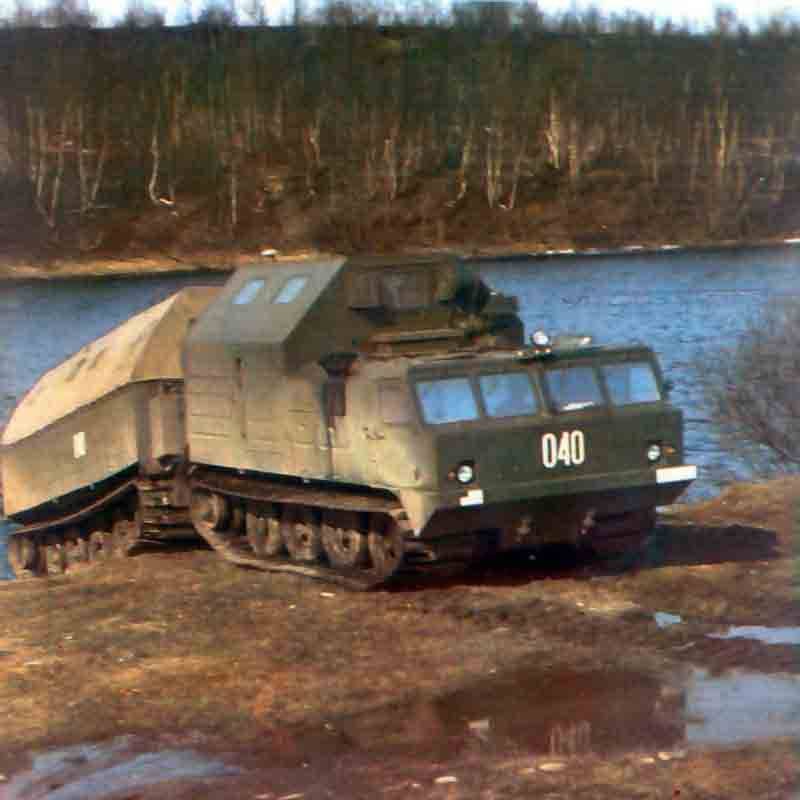
Inspired by the publications posted on the Courage website, I also decided to try my hand at proposing the concept of promising armored vehicles. Since I’m very interested in the two-link layout of armored vehicles (in particular, proposed by R. Ulanov), I tried to portray it as an alternative two-link heavy armored personnel carrier based on the Russian chassis tank T-55 (-54). Please do not judge very harshly.
1. INTRODUCTION
The combat vehicle proposed by the author with the conditional name DBTR-T (Two-link Armored Personnel Carrier - Heavy) can be considered as one of the promising alternative options for the modernization / conversion of old T-55 (-54) tanks into heavy tracked armored personnel carriers. (At one time, quite a large number of T-55 and T-54 tanks were produced - approximately 95 000 units, so this chassis is the most accessible). An example of such a implemented modernization is the Russian heavy BTR-T armored personnel carrier that exists in a single copy (photo 1).
BTR-T has clear advantages in armor protection over light BTR. Its main disadvantages are the small number of troops and the impossibility of dismounting the troops through the aft doors, which limits the possibility of using the BTR-T.
Theoretically, it is possible to eliminate these shortcomings on the BTR-T due to the front deployment of the logistics, but this will solve only the question of the possibility of more secure dismounting of the landing, the amount of which will still not be enough. Yes, and the alteration of a classic tank chassis into a platform with a front-mounted MTO is more like the creation of a heavy armored personnel carrier almost from scratch.
On the one hand, the proposed model by the author of the DBTR-T is devoid of the main shortcomings of the BTR-T, on the other hand, it is incorrect to fully compare these machines because of their main difference - the number of links: the DBTR-T has two of them at BTR-T.
The “relative” of the DBTR-T by the number of links is the two-section DT-30 “Vityaz” all-terrain vehicle (photo 2) generally known for its super-permeability, although its purpose is quite different.
Therefore, I will try to compare the characteristics of the DBTR-T with the same characteristics of the BTR-T, and also, in principle, to argue for the creation of such a vehicle, moreover, its cost will be equal to the cost of three BTR-T, and maybe more ...
Note
The two-unit armored personnel carrier DBTR-T proposed by the author (drawings and text) is a sketchy author's work that does not pretend to any exact technical and tactical conformity. The author is not an expert in this field.
2. PURPOSE
DBTR-T - high-security off-road armored personnel carrier with armor protection, not inferior to the protection of the BTR-T, but with almost twice as many crews - 13 people. The landing force has the possibility of leaving the link No.2 of the vehicle through the rear doors and upper hatches.
Due to the two-unit design, the DBT-T should significantly outperform all existing heavy tracked armored personnel carriers in all terrain and functionality. The base of the DBTR-T is universal and can serve to create a whole family of two-link machines with increased security and throughput.
3. COMPARISON BTR-T and DBTR-T
Comparative technical characteristics of the existing heavy armored personnel carrier BTR-T and proposed by the author DBTR-T:
Technical specifications | BTR-T | DBTR-T |
Original chassis | T-54 / 55 | T-54 / 55 (2 chassis) |
Combat weight, tons | 38,5 | 60 (28 + 32) |
Full crew, people | 7 | 13 |
- including landing | 5 | 10 |
Engine | 4-stroke, 12-cylinder turbo diesel | |
Engine make | B-55B / B-55U | B-92C2F2 |
Motor Power, hp | 580 / 620 | 1130 |
Power density, hp / t | 15/16,1 | 18,8 |
Transmission: | mechanical | electromechanical |
Speed forward / back, km / h | 50 / 5 | 50 / 50 |
Cruising on the highway, km | 500 | 500 |
Obstacle obstacles: |
|
|
- rise, hail | 32 | 35 |
- roll, hail | 30 | 30 |
- wall, m | 0,8 | 0,8 – 1,5 (maybe more) |
- ditch, m | 2,7 | 3 – 3,5 (maybe more) |
- ford without OPVT / with OPVT, m | 1,4 / 5 | 1,4 / 5 |
Ground pressure, kgf / sq. Cm | 0,86 | 0,8 |
ARMAMENT: | ||
Automatic gun | 1 x 30-mm 2A42 | 2 x 30-mm 2A72 |
Twin machine gun: | 1 x 7,62-mm PCT | 2 x 7,62-mm PCT; 2 x 7,62-mm coursework control PCT |
ATGM (ammunition) | 1 PU ATGM (2 ATGM) | 2 PU ATGM |
Frontal armor protection equivalent to homogeneous armor, -mm eq. | At least 600 | |
Dynamic protection | Built-in "Contact-5" | |
Dismounting assault | Only upper hatches | Top hatches and stern doors |
Main dimensions, mm: |
|
|
- length | 6450 | 11000 |
- width (on removable side screens) | 3270 | 4000 |
- height | 2400 | 2500 |
As we can see, the main advantage of the DBTR-T over the BTR-T is the increased maneuverability, more landing force and a wide range of weapons. The main disadvantage of the DBTR will be its cost - presumably 3 times the cost of the BTR-T (according to some estimates, the cost of reworking the T-55 in the BTR-T is 600 000 USD).
4. COMPARISON OF DBTR-T WITH FOREIGN WEIGHT BTR
Similar heavy armored personnel carriers have been actively used by the army of Israel since the end of the 1980s. The number of the first TBTR “Akhzarit”, created on the basis of the captured T-55 tanks, according to various data, ranges from 500 to 1000 pcs. In addition to the Akhzarit, there are two other models of TBTR in service with Israel: the 51-ton Puma based on the Centurion tank and the NaN 60-ton Namer based on the Merkawa Mc4 (photo 3). The creation by Israel of a new, more expensive and protected TBTR “Namer” on the basis of their most modern tank, once again confirms both the value and effectiveness of these armored personnel carriers in the army and the value of the lives of the crews of these vehicles for their leadership.
Technical specifications | DBTR-T1 | TBTR "Ahzarit" (Mk-2), | TBTR "Timer" |
Chassis | T-55 (-54) | T-55 | Merkava Mk4 |
Year of construction | - | November 1988, XNUMX | November 2008, XNUMX |
Combat weight, t | 60 | 44 | 60 |
Full crew, people | 13 | 10 | 11 – 12 Feet |
Of them landing, pers. | Until 10 | 7 | 8 – 9 Feet |
Motor Power, hp | 1130 | 850 | 1200 |
Power density, hp / t | 18,8 | 19,3 | 20 |
Speed km / h | 50 | 50 | 60 |
Power reserve, km | 500 | 500 | 500 |
Main armament | 2 x 30-mm AP + | 1 x 7,62-mm DU machine gun | 1 x 12,7-mm DU machine gun / or: |
Auxiliary weapons | 2 x 7,62-mm course machine gun | 1 x 7,62-mm machine gun | 1 – 2 x 7,62-mm machine gun: |
PU ATGM | 2 pc | no | no |
Frontal armor protection | Counter | Counter | Counter |
Dynamic protection of front and side armor: | Yes | Yes | Yes |
Length: | 11 mm | 6450-mm | 7450-mm |
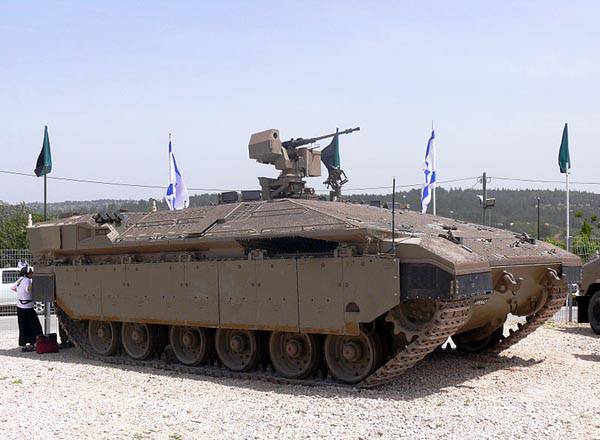
Comparative data in the table show that the estimated characteristics of the DBTR-T are at the level of one of the most protected TBTR “Namer” in the world. The alternative DBTR-T is inferior to the Israeli vehicle in armor protection (especially in the upper and side projections of the hull), but surpasses it in maneuverability, armament and functionality.
It’s not possible to follow the “Namer” booking level in the two-link DBTR, since “Namer”, with its length of almost 7,5, already has a mass of 60 tons, and a similar booking of 11-meter DBTR-T will make it at least 80 tons .
When modeling the DBTR-T, the author set the upper mass limit of the machine in 60 tons. This is the mass that the standard engine of the T-90CM tank should take in view of reducing the maximum speed from 60 to 50 km / h.
5. MODIFICATIONS DBTR-T
Let us consider theoretically possible variants of the DBTR-T, which can potentially be in demand in the army:
Model | Purpose | Armament (ammunition) |
DBTR-T | The basic or most budget model, roomy troop compartment allows you to use the machine as a TBTR and as a flamethrower fighting machine. There are loopholes in the stern doors of link No. 2 for firing from inside the machine | 2 x 7,62-course headings PCT (2 x 1000 ammo); 2 x12,7-mm remote control NSVT (900 ammo / 6 stores). |
DBTR-T1 | Combat model with reinforced weapons for fire support of the landing force and tanks. In fact, the car is similar to BMPT "Terminator-1" with a crew of five people + 8 paratroopers. The armament complex on the scheme without change was borrowed from one of the prototypes of the BMPT, created in 1980-s. A machine can hit different targets at the same time with 4. | 2 x 7,62-course headings PCT (2 x 1000 ammo); 2 x 30-mm AP 2A72 (2 x 300 shells); 2 x 7,62-mm paired FCT (2 x 1000 cartridges); 2 PU ATGM |
DBTR-T2 | The combat model with advanced weapons in function is more like a heavy BMP. The difference from the previous model in the fully remote prospective combat module installed above the troop compartment of the link №2. The 2А11 cannon is taken as a temporary solution, with the goal of mastering the remote-exploding projectiles until the new automatic guns of the 40-45-mm caliber appear. | 2 x 7,62-course headings PCT (2 x 1000 ammo); 1 x 37-mm AP 2A11 (in the future 40-45-mm AP); 1 x 7,62-mm paired PKT; 1 x 40-mm paired AG; 4 ATGM “Attack” |
DBTR-TR | Intelligence vehicle | 2 x 12,7-mm control NSVT. |
DBTR-BREM | Repair and recovery vehicle. For this machine, a full-size X-NUMX-roller T-5 / 55 chassis for the 62-link can be used, the necessary limitation in this case is the weight of the link - up to 2 tons | 2 x 12,7-mm control NSVT. |
DBTR-KSHM | Command vehicle | 2 x 12,7-mm control NSVT. |
DBTR-SAM | Sanitary evacuation vehicle | No armament |
All of the above machines differ only in the link number XXUMX. Link number XXUMX remains almost unchanged in all versions, which increases the unification of these alternative machines. In variants DBTR-TR, BREM and KSHM, exchange rate 2-mm machine guns are removed from the fenced shelves of chassis No.1, instead of them one or two 7,62-mm NSVT machine guns are installed (standard T-1 and T-12,7 tank commanders). Replacing machine guns due to the impossibility of course machine guns to provide all-round protection for the machine, which can be provided by an all-round tank revolver.
Next will be briefly considered two options for possible power plants. The proposed transmission - electromechanical (EMT), however, understanding its complexity and high cost, the layout of the DBTR-T is designed in such a way that it is possible to use both purely mechanical and electromechanical transmissions.
6. ARMAMENT
Link No.1 in the version DBTR-T / Т1 and Т2.
The armament of the No. 1 link in the DBTR combat models consists of two course 7,62-mm PKT machine guns, they are remotely controlled by two operators. An important issue will be the angles of horizontal guidance of machine guns, so that they provide a good zone of fire, to the maximum protecting not only the frontal projection, but also the side. Ammunition consists approximately of two tapes of 1000 cartridges each.
The location of the machine guns on above the track shelves is determined by the location of the link arms No. XXUMX, which has a circular rotation.
Theoretically, it would be correct to create universal remotely controlled installations that can equip both 7,62-mm FCT and 30-mm AGS-17D, as was done at the Terminator-1 BMPT, only with large pointing angles.
The advantages of such weapons: large ammunition in the 1 tape (1000 ammunition);
Disadvantages: limited pointing angles.
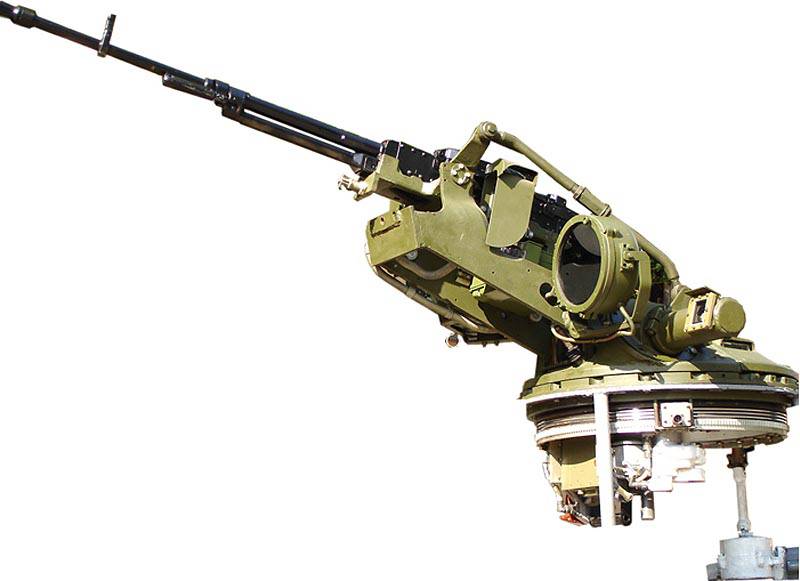
Link number XXUMX in other versions. The link No.1 in the “auxiliary” modifications of the DBTR-T is armed with a standard tank anti-aircraft machine-gun installation (ZPU) of 12,7-mm caliber (photo 4).
The use of standard machine gun installations from T-64A and T-80 tanks is assumed, as they allow the operator to fire a machine gun without protruding from the vehicle. The machine gun installation has an electromechanical drive and provides horizontal circular guidance in the 360 sector of degrees and horizontal in the range from -15 to + 85 degrees. The unit has day and night sights, there is no two-plane stabilizer. The range of the machine gun - 1500 m, ammunition - 3 box on 150 ammunition for each machine gun.
The author chose the ZPU machine-gun installation for reasons of crew security, since for firing from the anti-aircraft machine gun of the T-72 tank, the arrow must be protruded from the hatch.
On the link number XXUMX can be installed one or two ZPU above hatches shooters. The advantages of such weapons: excellent pointing angles; disadvantages: limited ammunition in 1 cartridges.
Link №2 basic model DBTR-T. This modification of the link can be used as an armored personnel carrier, and as a combat vehicle flamethrower. Given the lack of loopholes in the side armor of the second link of the vehicle, two commander's turrets of T-64 / 80 tanks, which have a circular rotation, are mounted on its roof. The turrets are equipped with standard NSVT-12,7 machine guns. Estimated ammunition - on 4 boxes on the machine gun (1 on the machine gun, 3 in the troop compartment).
DBTR-T in the base configuration provides simultaneous destruction of 4's of various targets. In terms of this indicator, it surpasses the BMP-3, BMD-3 / 4 and BMPT "Terminator-1". In the rear doors of the troop compartment provides loopholes to be closed with a lid for firing from personal weapons in the direction of the stern.
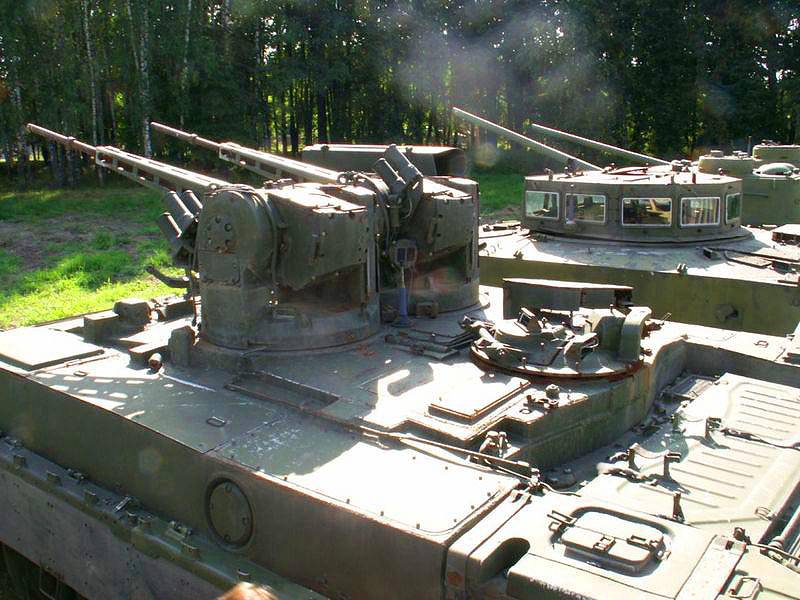
Link №2 combat model DBTR-T1. The link has more powerful armament, consisting of two independent gun installations of caliber 30-mm with paired 7,62-mm PKT machine guns. On the right (in the direction of travel) a gun installation mounted launcher for two anti-tank guided missiles. The cannons were completely borrowed from the prototype BMPT 2-th modification (photo 5).
Why is this weapon chosen? The compact dimensions of the links required to increase the maneuverability of the vehicle (the total length of each link is 5000 mm) do not allow simultaneously with the landing force to place in the link 2 the fighting compartment of a two-seat tower with more powerful weapons, for example, with C-57 or “pairing” X-gun. from 60-mm 100A2 and 70-mm 30A2. In addition, the double tower must have a powerful armor protection at the level of protection of the hull, which will inevitably weigh down the tower itself, and the entire machine as a whole.
Unlike the two-man inhabited tower, the weapons complex of an experienced BMPT with the conventional name No. XXUMX can provide several advantages at once:
+ additional protection of the roof of the troop compartment at the location of the weapon;
+ two different targets hit at the same time, for example, if the DBTR-T falls under simultaneous fire from two opposite sides;
+ the possibility of hitting one target (or a cluster of targets) from 2-x guns and 2-x machine guns at the same time;
+ in case of failure of one tool, there is the second;
+ Armament carried out reduces the gas contamination of the troop compartment.
Disadvantages of this option:
- guns overlap each other sector of fire at certain angles of rotation,
- the lack of a modern MSA and limited capabilities in the fight against highly protected targets (tanks, pillboxes, bunker tanks, etc.).
Thanks to its powerful booking DBTR-T1, if necessary, it can be used as a full-fledged BMPT, or accompany tanks while performing the tasks of the APC and BMPT. According to its weapons, DBTR-T1 can fully substitute two infantry fighting vehicles for the BMP-2 or two BMD-2 infantry.
Link №2 combat model DBTR-T2. A promising set of weapons.
In this case, the author provides for the installation of a fully automatic tower, which will not “eat up” the useful volume of the troop compartment. The tower is commanded by the commander and the operator, who “permanently” sit under the tower and receive information on the monitors. The armament of such a module consists of an 37-mm anti-aircraft gun 2А11 from ZSU “Yenisei” with air-cooled barrel and correspondingly lower rate of fire (200-300 rds / min). Power feed two tape. 7,62-mm PKT machine gun and AGS 40-mm grenade launcher are paired with a gun.
Why caliber 37-mm? It is believed that for promising 30-mm artillery systems is no longer enough, for a 57-mm you need a volume turret section. The author considers the 37-mm "golden mean", or rather the "temporary" middle, while there is no automatic gun caliber 40-45-mm.
Even in its current form, the 37-mm OB shell has almost twice the mass than the 30-mm OB shell. In addition, according to various information - 35 ... 37-mm minimum caliber, which is already appropriate to equip with a remote fuse.
The gain of 37-mm BPS in front of the 30-mm projectile in the thickness of the pierced armor is visible only at a distance of 1000 m.
As a guided weapon, the BMPT Terminator-2 complex of four Ataka-T missiles is used.
The advantages of such weapons: a modern weapons complex and MSA, fully automatic ammunition, the ability to hit more complex targets such as tanks and combat helicopters of the enemy;
Disadvantages: a bulky tower, which can not be given the level of body armor, similar to the body of the armored personnel carrier. The tower will theoretically be very vulnerable even to small-caliber automatic guns.
7. TRANSMISSION DBTR-T
The considered type of transmission for DBTR-T is an electromechanical transmission. On the one hand, the use of such a transmission contradicts the basic concept of the DBTR-T - a budget and simple machine made on the basis of old T-55 tanks. On the other hand, its presence significantly expands the capabilities of the DBTR-T, as a result of which, it should significantly exceed all existing heavy armored personnel carriers in terms of maneuverability, functionality and other performance indicators.
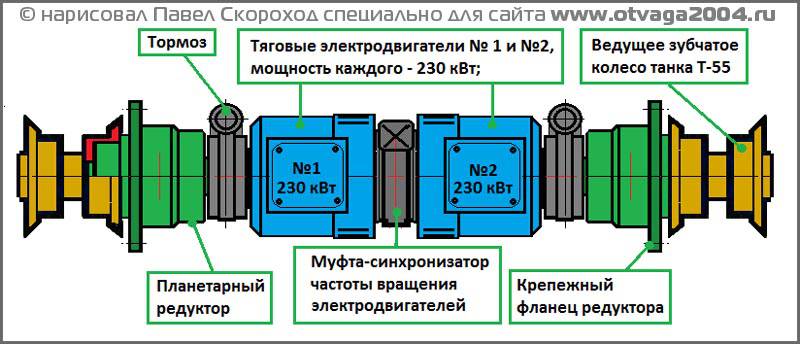
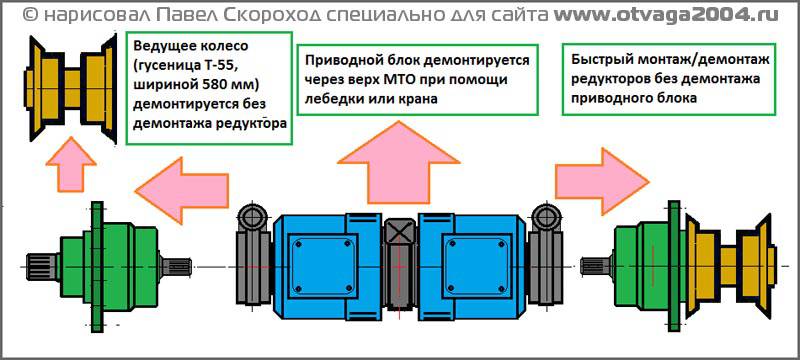
The transmission shown in the sketch is the same for links №1 and №2. On link number 1, it is installed “classically” in the rear part of the logistics, instead of the old mechanical transmission of the T-55 tank. Link №2 - a similar unit is installed in the front, as there are two doors in the stern for dismounting the landing.
What are the benefits of an expensive EMT dual armored personnel carrier?
+ The ability to quickly disengage the links for loading / unloading DBTR on road or rail transport.
The length of each unlinked link is no more than 6000-mm. Disengagement is performed by the crew. Both links independently call in on platforms / tractors / wagons, etc. using a special power cable with a length of 10-15 m, through which power is supplied from the driving link (No. 1) to the driven link (No. 2). To control the slave link, the driver goes to the link number XXUMX, to the place of the commander, where there are direct controls for the transmission of the link number XXUMX. At the time of the maneuvers of the link №2, the link №2 still works in the mode of the generator of electricity.
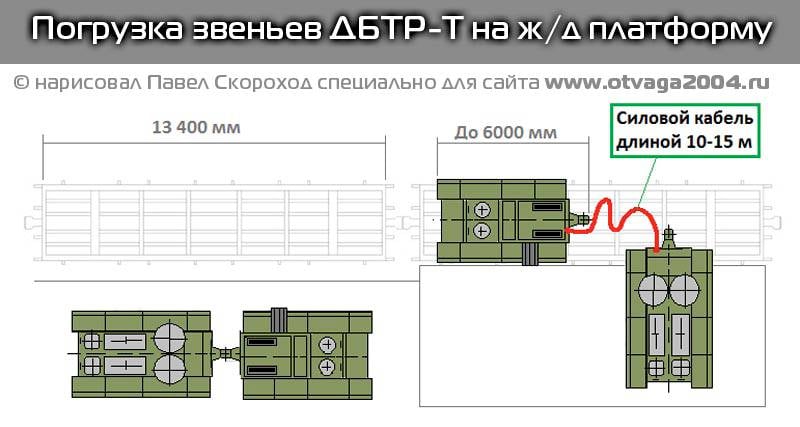
+ Evacuation of damaged links separately from difficult road sections (mountain roads, narrow streets, forest, etc.) due to the possibility of separation of links and the possibility of towing these links using an external generator or other DBTP-T.
+ Applications of various types of engines without changing the transmission. The author proposed two versions of DBTR-T with diesel engines of the “B” series of the T-90 tank and with gas turbines (GTE) of the T-80 tank.
In the future, in the course of development and availability of alternative fuels and energy sources, the integration of a power unit based on fuel cells that generate electricity due to the chemical reaction of the fuel is possible.
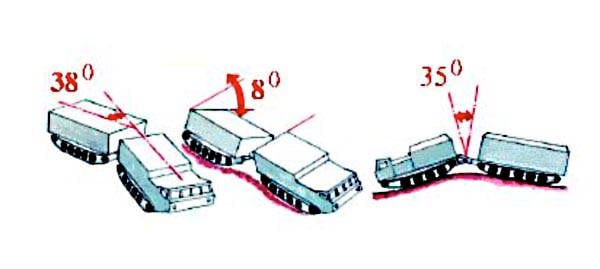
+ “Flexibility” DBTR-T. As is known, two-link articulated machines have three degrees of freedom of movement relative to each other, respectively, and three ranges of restrictions of this movement. For example, the DT-30P “Vityaz” two-link conveyor (with a mechanical transmission - a cardan shaft) has the following range of degrees of freedom of movement:
- angles of rotation of the links relative to the longitudinal axis: +/– 38 hail;
- angles of lifting links relative to each other: 35 hail;
- the angle of "twisting" of the links relative to each other: 8 deg.
The absence of a rigid mechanical transmission of torque (propeller shaft) of the DBTR-T engine from the link No. 1 to the transmission of the link No. 2 may allow increasing the range of these limitations. Given the functional purpose of the DBTR-T, the most important is to increase the ranges of angles of rotation of the links relative to the longitudinal axis (No. 1 in the diagram), in this case, the EMT flexible power cable will not be any limitation to this degree of freedom of movement. The sketch layout of the DBTR-T is drawn with regard to the maximum range of angles of rotation of the links: ± 45 ... 50 deg.
+ Reversing. The long length of the DBTR-T (11 000-mm) significantly limits its mobility in a combat situation in comparison with other combat vehicles (TBTP, BMPT, BMP), whose body length does not exceed 6 500 – 7 500-mm. Thus, DBTR-T is almost completely deprived of the possibility of a turn on mountain roads or on the streets of cities and settlements.
This design flaw can be partially compensated by increasing the maximum speed in reverse to the value of the maximum forward speed - 50 km / hour (for comparison, the speed of reversing BTR-T on the basis of T-55 is only 5 km / hour).
The increase in reverse speed for EMT DBTR-T is not particularly difficult. In the machine control compartment, a rearview video monitor and a reverse camcorder are provided, mounted on the stern armor plate No. XXUMX.
+ Traction characteristics. The main unique advantage of the DBTR-T is its increased maneuverability in case of “heavy armor”.
Given that all the most difficult obstacles (trenches, anti-tank ditches, walls, steep climbs, forest belts, off-road, low load bearing soils, etc.), the DBTR-T will overcome at low speed, it needs the highest rate of torque. at these low speeds. It is known that EMT provides high torque at low speeds, which is its main advantage.
Of stories. Even during the Great Patriotic War, EMT was used on the heaviest tanks and SPGs: serially installed on the German heavy self-propelled gun Ferdinand weighing 68 tons, the prototype super-heavy tank Maus weighing 180 tons, on the Soviet experimental heavy tank EKV (version KV -1) and post-war heavy tank EC-6
+ Towing equipment. Taking into account the alleged high characteristics of cross-country DBTR-T, it will be entrusted with the task of towing damaged equipment or simply stuck combat vehicles on difficult terrain. In any case, towing will be done at low speed, at which high torque will also be needed.
+ Ability to connect 3-th link. For individual modifications of the DBTR-T, it is theoretically possible to connect the 3 of the lightweight link (similar to the DT-30P transporter).
In case the DBTR-T will be used as a repair and recovery vehicle or a high-performance vehicle for the transport of infantry and weapons / ammunition, it is possible to add the link No.3 (with a similar transmission), which will be between the link No.1 and No.2.
8. POWER INSTALLATION DBTR-T
The author proposes to create a promising DBTR-T based on the chassis of the T-55 tanks with diesel engines of the “B” series, as a result, the power plant based on the “B” series engine is also supposed to be used as the basic power unit; 92 hp, tank T-2CM.
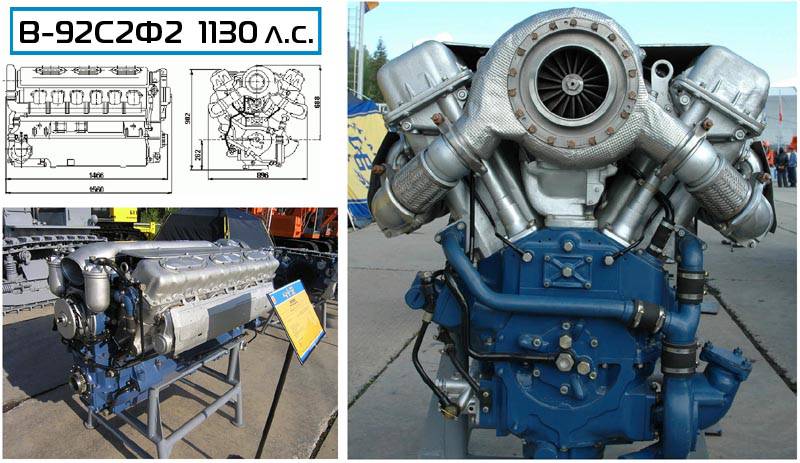
The use of the “top-end” version of the engine of this series increases the cost of the potential production of DBTR-T, but it is this power that is necessary to ensure the high mobility of the rather heavy DBTR-T, whose armor is equivalent to the tank one.
As an alternative power unit without a fundamental change in the transmission (in the case of EMT), a gas turbine of a gas turbine engine, a T-80 tank, can be used. It is quite obvious that the use of a more expensive gas turbine can be justified only for special machines, for example, intended for permanent service in colder regions where the "winter" advantages of gas turbine engines are necessary.
You can consider two modifications DBTR-T by type of power plant:
- “Standard” modification DBTR-T with a tank engine B-92, power 1130 hp;
- “Northern” modification with a gas turbine tank engine, power 1250 – 1400 hp
Some parameters of engines for comparison:
Technical specifications | DBTR-T "standard" | DBTR-T "northern" |
Engine make | B-92C2F2 | GTD-1250 |
engine's type | Piston turbodiesel | Gas turbine engine |
Engine starting | Electric, compressed air, from the tug | Электрический |
Power, hp | 1130 | 1250 |
Specific power DBTR-T, hp / t | 18,83 | 20,83 |
fuel type | Multi-fuel | Multi-fuel |
Specific fuel consumption, g / hp * hour | 158 | 225 |
Engine weight | 1100 | 1050 |
Resource of the engine before repair, motochas | 1000 | 1000 |
Overall dimensions, mm: Length: Width: Height: | . 1560 896 902 | . 1494 1042 888 |
Minimum engine start operating temperature | -20 ° C | -40 ° C |
In terms of weight and dimensions, the engines are almost identical, in addition to the high cost of a gas turbine and greater fuel consumption, it will also be necessary to resolve the issue of removing the hot air from the cooling system and exhaust, which cannot be sent back, as is done on T-80 tanks.
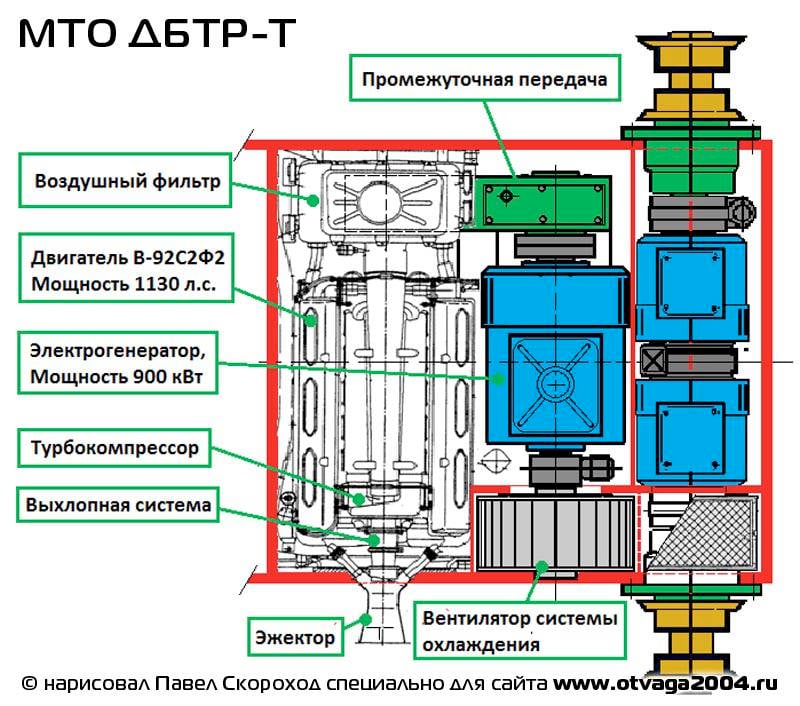
It is likely that if the DBTR-T will be produced, it will be mainly in one more “budget” standard modification with the B-92C2F2 engine, since the problems associated with the simultaneous presence in the army of main tanks with fundamentally different power units (T-80 and T- 72 / 90) everyone is well known.
Another argument in favor of the B-92 may be its untapped potential for increasing power. The use of improved fuel systems, modern air purification systems, a more efficient cooling system, friction reducing additives, etc. could theoretically increase the power of this engine to 1200 hp and maybe more ...
The B-92C2F2 engine is located transversely to the longitudinal axis of the hull (that is, similar to the T-44 / -54 / -55 / -62 / -72 / -NNXX) tanks. Torque from the engine is transmitted to the generator through an intermediate gear, similar to that used on T-90 tanks… .44. Power generator - 90 kW (900 hp) in case of a possible diesel boost with 1215 hp to 1130 hp The total power of the 1200-x traction motors is 4 x 4 = 250 kW, which is enough for a standard T-1000CM tank engine as well as for a well-forced (in perspective) HP 90.
9. COMPONENT DBTR-T
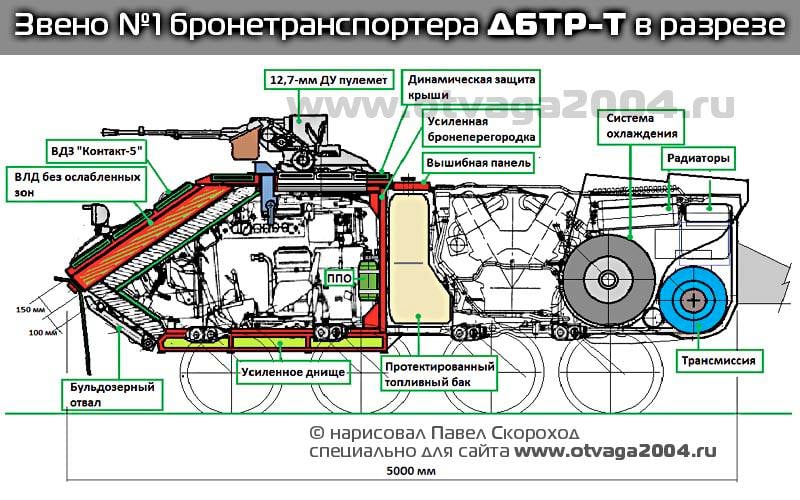
Link number XXUMX. For maximum simplification of the alteration of the original T-55, the link No.1 has a classic “tank” layout. The crew of three people is in front of the hull, its location is completely identical to the location of the crew of the Terminator-1 BMPT (mechanic drive and two AGS operators). When reworking, the standard T-55 body is shortened by an 1 roller, the total length of the shortened body is approximately 5000-mm. Here the reader's question is “why shorten?”, I will try to answer from my point of view:
"Initially, the author drew two articulated full-size 5-roller T-55 chassis - visually, the DBTR-T turned out to be very long and therefore less manoeuvrable, and in terms of mass, with normal armor (the BTR-T level), its mass with that length would be 70 -75 tons. It is clear that the "top" B-92 in 1130 hp it is unlikely to pull this colossus at a speed of more than 30-35 km / hour ... ".
The internal fuel tanks are located behind the control compartment, they are separated from the crew by a reinforced armored barrier, which increases the rigidity of the control compartment design, which, in essence, becomes like an armored capsule. The seats of the driver and two crew members are attached to the roof of the office. For landing-disembarking the crew there are three hatches in the roof of the hull and one emergency in the bottom of the hull behind the driver’s seat between the seats of two other crew members.
External fuel tanks are located on the right and left fenders.
Internal fuel tanks are isolated from the crew and MTO two armored bulkheads. In the MTO section there is a B-92C2F2 engine (transversely to the longitudinal axis of the housing) an electric starter is located parallel to the engine. The transfer of engine power to the generator is carried out through an intermediate gear ("guitar"), similar to that used on T-54 ... 90. The cooling system fan is driven from the main generator shaft through a variator that changes the frequency of rotation of the fan impeller depending on the engine load. Behind the generator there is an 1 unit of EMT and a hydraulic system of the rotary mechanism actuators of the links.
In all trim levels DBTR-T on NLD link number XXUMX is a standard tank dump for self-digging. If necessary, the installation of a dozer blade with hydraulic drives is assumed.
To force water barriers along the bottom, it is planned to install two OPVT pipes - one on each link 1-m and 2-m.
Link number XXUMX. Link No.2 is also converted from the hull of the T-2 tank, shortened to four track rollers on board (approximately 55 mm in length). The unit EMT link №5000 is similar to the unit EMT link №2 it is only located in front of the link №1. In the transmission compartment there is an auxiliary diesel generator, with a capacity of 2 – 10 kW for autonomous power supply of two links. In the same department is supposed to place the air conditioner.
Behind the transmission compartment there is a combat and amphibious compartment, designed for 10 people. The height of the link №2 in the area of BO and the troop compartment is slightly higher than the link №1.
Embarkation / disembarkation of the crew can be carried out through two stern doors and 4 upper hatch.
The crew seats are placed along the sides (5 on each side) of the link and are attached to the compartment roof. Tanks with fuel in the troop compartment no. External fuel tanks are located on the fences, the fuel from them is transmitted through flexible hoses to the link number XXUMX.
Each link is an individual FVU, which differs in performance depending on the number of crew.
10. DBTR-T PROTECTION
Frontal projection. The armor durability of the DBTR will be presumably at the level of the existing Russian BTR-T. Persistence of frontal armor against CS is equivalent to 600-mm homogeneous armor (in perspective - 1000 mm). The VLD of the link body No. 1 is “covered” by the built-in DZ “Contact-5”. The NLD hull consists of a homogeneous armor sheet with a thickness of 100-mm inclined at an angle of 55 hail (similar to the T-55 tank) and additionally “covered” with a blade for self-digging. Frontal armor link number XXUMX should provide protection from:
- cumulative rocket-propelled grenade launchers RPG-7;
- BPS guns caliber 100-105-mm at a distance from 1000 m and more;
- BPS 57-mm guns at any distance.
Unlike the BTR-T, the landing of the new two-link armored personnel carrier DBTR-T is much better protected, since the entire frontal strike will be taken over by the link No.1 covering the troop compartment with its body. Even in the event of defeat and failure of the link №1, the landing force can easily leave the link №2 and also fire from the weapons installed on it.
Side armor. Protection of the machine from the sides is provided by the side armor, 80-mm thick (thickness of the side armor T-55), side removable screens with remote elements are additionally installed. The side armor complex should protect the DBTR-T board from:
- rocket-propelled grenades RPG-7 grenade launcher with a tandem cumulative warhead;
- armor-piercing shells (BPS) automatic guns caliber 30-37-mm at any distance;
- BPS 57-mm C-60 guns at a distance from 1000 m and more.
The distance between the side screens and the inner side armor sheet is approximately 600-650 mm. The outer, protected fuel tanks are located between the removable screen and the main armor, providing additional protection against the CS.
Roof. Taking into account the fact that the control unit of the link №1 will be under the gun of a grenade launcher, the roof of the control unit is additionally protected by a DZ and hatches have additional protection similar to the protection of hatches of the operators of the grenade launchers of the BMPT Terminator-1.
The roof of the troop compartment unit No. 2 is also additionally protected by DZ blocks.
The bottom in the area of the branch of the management of the link №1 is additionally reinforced by the welded armor with internal filler. Due to the reinforced reservation of the bottom in the area of the management office, the clearance is reduced by 100-mm. The internal armored partition with additional spacers behind the driver’s seats and two crew members are a stiffener between the bottom and the roof of the hull, which increases the stability of the bottom in the area of the separation of control from the explosive effect of mines and land mines.
Stern. The thickness of the No. 1 and No. 2 feed armor links is 45-mm, they provide protection against armor-piercing bullets of the 14,5-mm caliber released at close range and BPS of the 30-mm caliber at a distance of 500 m and further. Aft doors of the troop compartment are equipped with protivokumulyativnye trellis screens installed at a distance from the door for the premature actuation of the charges of cumulative ammunition.
Automatic high-speed software is installed in each link and operates independently of each other. Additional software is located in the MTO link number XXUMX.
On the roof of the link No. 1 and the link No. 2, sensors for warning about laser irradiation of the machine are installed for automatic ejection of smoke grenades.
The system of active protection of KAZ by the author is not yet provided, since this is a separate work.
New security features. Finally, the new heavy tracked vehicle gets a unique opportunity to independently evacuate from the shelling when the track breaks. In the event of damage and destruction of any of the tracks of the link №1, the DBTR can be independently evacuated at the expense of the driving propeller of the link №2, the transmission of which can be removed from the main engine-generator to 500 kW of power (675 hp).
11. ADVANTAGES AND DISADVANTAGES OF DBTR-T
Advantages:
+ high permeability;
+ specific pressure at the level of 0,8 kgf / cm2 with a mass of 60 tons;
+ Increased crew protection level number XXUMX, which is actually in a powerful armored capsule;
+ large troop compartment on 10 people;
+ the possibility of landing dismounted through the rear doors;
+ powerful weapons;
+ Multifunctionality DBTR-T and the potential to create a family of machines based on it;
+ fuel and fuel were removed from the control compartment and the landing compartment, which reduces the fire / explosion hazard of the machine;
Disadvantages:
- the high cost of the car (approximately 3 times more expensive than the BTR-T);
- large mass of the machine (60 tons);
- forward speed - 50 km / h, which can lead to lagging DBTRs on the march from other, faster combat vehicles;
- the absence of lateral embrasures in the link number XXUMX;
- the lack of a commercially available military version of EMT, which could be used in DBTR-T;
- the need to use the most powerful version of the engine "B", which excludes the possibility of using old engines with 580 / 620 / 780 / 840 and 1000 hp.
- the need for an additional cooling system for the traction motors and the generator;
- a driver and two arrows, when leaving the car through the upper hatches get under fire;
- the need to install two systems PPO, FVU and two air conditioners;
- Side exhaust increases the visibility of the car.
Possible prospects for further modernization:
• installation of a promising X-shaped diesel generator, power from 1200 hp;
• increasing the speed of movement up to 60-70 km / h due to the use of a more powerful engine;
• installation of KAZ to increase the security of the machine;
• installation of a promising 40-45-mm automatic cannon instead of the “temporary” 37-mm 2-11 for the DBTP-T2 model;
• use of a simpler mechanical or hydromechanical transmission to reduce the cost and ease the machine. At the same time, the DBTR-T will lose some advantages in cross-country ability, but also win a couple of tons of weight that can be used to increase armor or increase power density at the same reservation level;
• installation in the aft section of the No. 2 of two remote control guns, caliber 5,45 – 7,62-mm for additional protection of the machine from the sides.
12. CONCLUSION
At the end of this article, it would be right to once again return to the question “Does the army of the DBTR-T need at the price of three BTR-T?”, As during the simulation of the possible characteristics of the DBTR-T the idea of a budget rework of old T-55 tanks almost disappeared , perhaps, is the main disadvantage of this machine.
Of the other "pluses" / "minuses" of the machine, not included above:
+ One DBTR-T by the number of troops (10 people instead of 5 people) is already equal to two BTR-T, and the troops have more chances to safely leave the car through the rear doors, which are not on the BTR-T.
The undermining of the DBTR-T on an anti-tank mine or a powerful land mine also gives the landing party a much better chance of salvation - the main attack is taken by link #1, which does not have a tight connection with link #2.
+ If a caterpillar breaks up on a mine, the DBTR can independently go backwards in ambush, while maintaining the lives of the crew and the landing party.
+ Breaking frontal armor with modern ammunition will be disastrous for the entire crew of the BTR-T (7 man) while the landing compartment of the link № 2 DBTR-T (10 man) will remain intact.
+ If we count by the criterion of crew survival (if such a criterion exists), it turns out:
With a complete set of vehicles crews and frontal defeat:
• one DBTR-T will be equal to the 2,33 BTR-T if the 1 of the person is in the 3 link (7 / 3 = 2,33);
• one DBTR-T will be equal to 3,5! BTR-T, if the 1 person is in the 2 link (7 / 2 = 3,5);
- In the case of side or stern lesion of the link No. 2 DBTR-T (10 man), the proportion unfortunately changes in the opposite direction: 1 DBTR-T = 0,7 BTR-T.
+ In weaponry, the DBTR-T1 model fully exceeds two BTR-Ts at once, both in the number of trunks and in the number of simultaneously hit targets.
Despite the last point, it turns out that the above comparisons cannot fully justify the high cost and feasibility of the DBTR-T.
Perhaps the main trump card remains - one DBTR-T will pass where there are not three or more BTR-T!
And if this argument becomes decisive - there is a chance that similar machines will still be developed and produced.
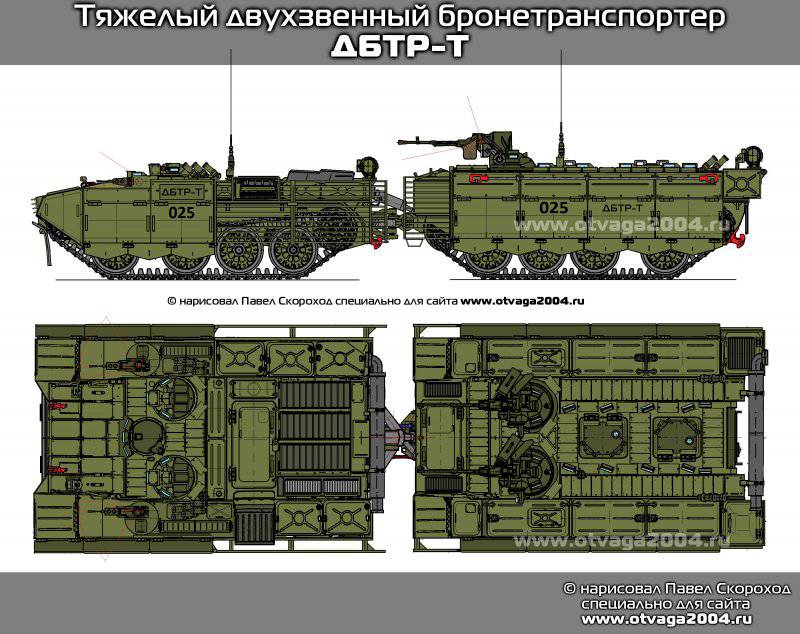
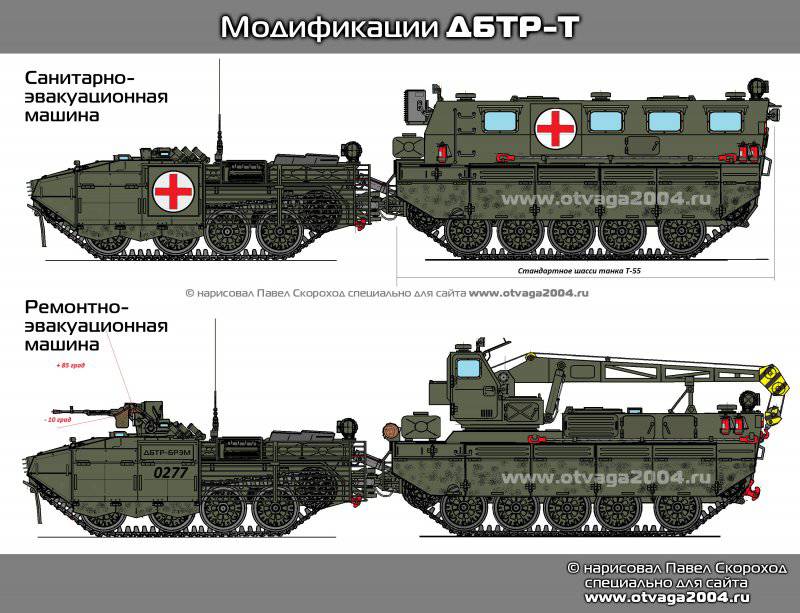
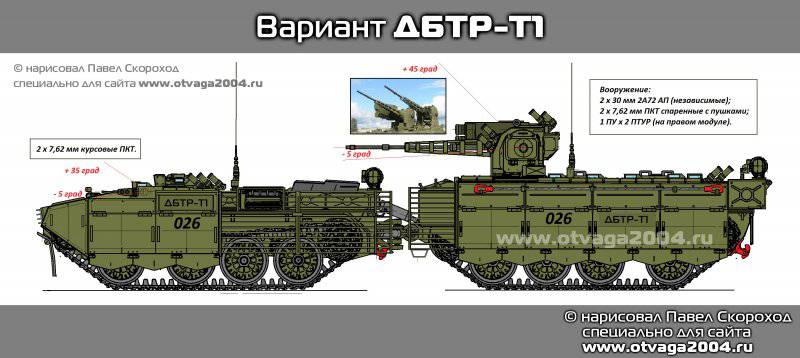
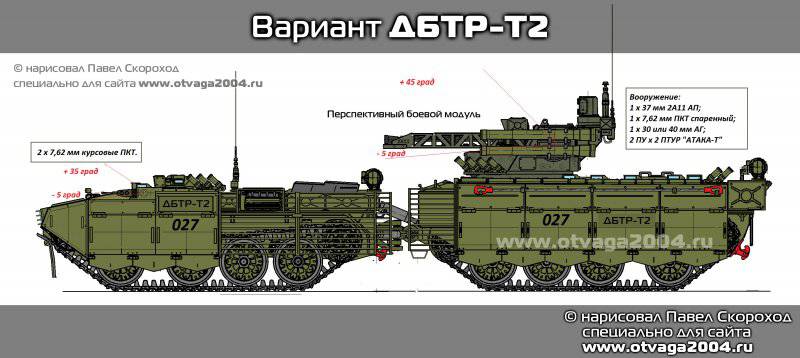

Information